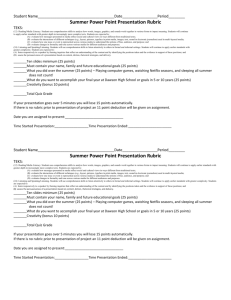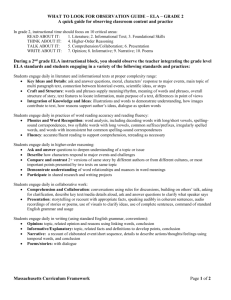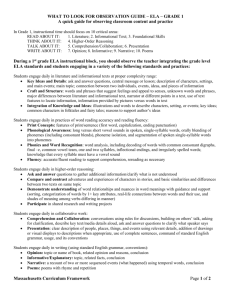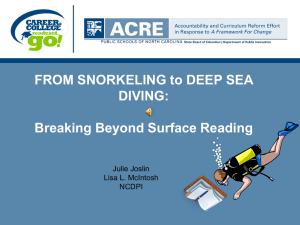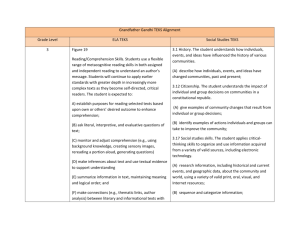Adding Depth and Complexity to Your Lessons Grade Level(s): 2
advertisement
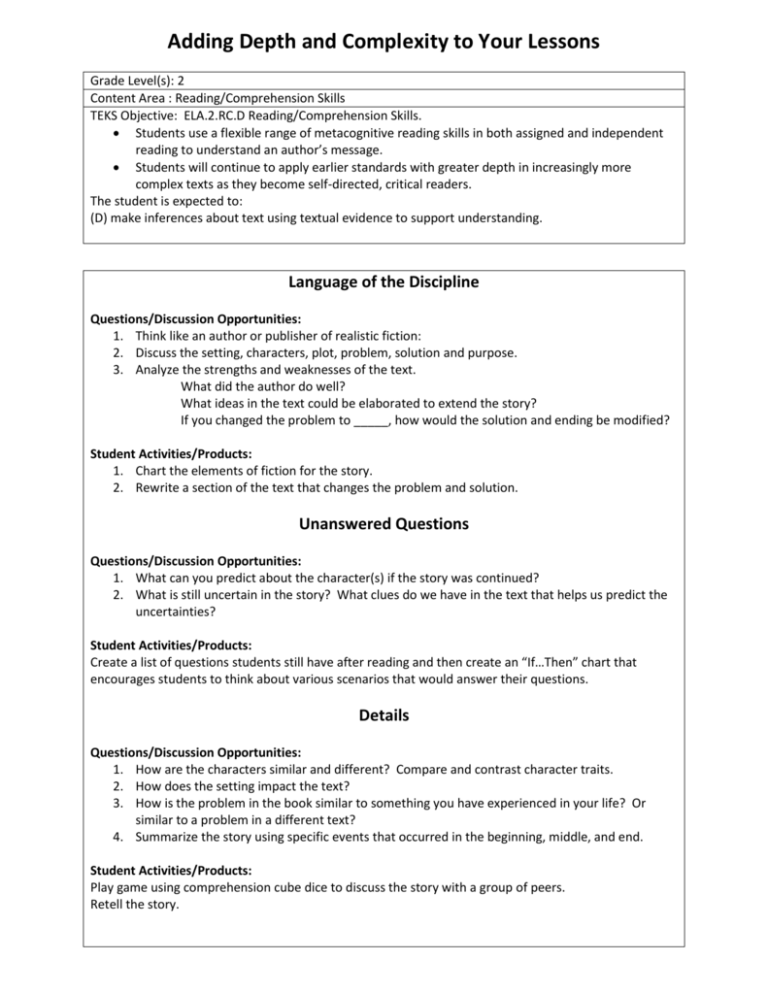
Adding Depth and Complexity to Your Lessons Grade Level(s): 2 Content Area : Reading/Comprehension Skills TEKS Objective: ELA.2.RC.D Reading/Comprehension Skills. Students use a flexible range of metacognitive reading skills in both assigned and independent reading to understand an author’s message. Students will continue to apply earlier standards with greater depth in increasingly more complex texts as they become self-directed, critical readers. The student is expected to: (D) make inferences about text using textual evidence to support understanding. Language of the Discipline Questions/Discussion Opportunities: 1. Think like an author or publisher of realistic fiction: 2. Discuss the setting, characters, plot, problem, solution and purpose. 3. Analyze the strengths and weaknesses of the text. What did the author do well? What ideas in the text could be elaborated to extend the story? If you changed the problem to _____, how would the solution and ending be modified? Student Activities/Products: 1. Chart the elements of fiction for the story. 2. Rewrite a section of the text that changes the problem and solution. Unanswered Questions Questions/Discussion Opportunities: 1. What can you predict about the character(s) if the story was continued? 2. What is still uncertain in the story? What clues do we have in the text that helps us predict the uncertainties? Student Activities/Products: Create a list of questions students still have after reading and then create an “If…Then” chart that encourages students to think about various scenarios that would answer their questions. Details Questions/Discussion Opportunities: 1. How are the characters similar and different? Compare and contrast character traits. 2. How does the setting impact the text? 3. How is the problem in the book similar to something you have experienced in your life? Or similar to a problem in a different text? 4. Summarize the story using specific events that occurred in the beginning, middle, and end. Student Activities/Products: Play game using comprehension cube dice to discuss the story with a group of peers. Retell the story. Adding Depth and Complexity to Your Lessons Grade Level(s): 2 Content Area : Reading/Comprehension Skills TEKS Objective: ELA.2.RC.D Reading/Comprehension Skills. Students use a flexible range of metacognitive reading skills in both assigned and independent reading to understand an author’s message. Students will continue to apply earlier standards with greater depth in increasingly more complex texts as they become self-directed, critical readers. The student is expected to: (D) make inferences about text using textual evidence to support understanding. Patterns Questions/Discussion Opportunities: Identify the repetitive themes in the author’s work. Compare multiple texts written by the author. 1. Are there any phrases that are repeated throughout the text? 2. Why would the author choose to repeat this phrase? Student Activities/Products: 1. Read multiple texts by the author and find patterns (look at theme, characters, setting, problem etc.) 2. Write a story that follows the same text pattern or the same characteristics of the author’s style. Rules Questions/Discussion Items: 1. What rules are following when writing realistic fiction? Review characteristics of realistic fiction. 2. What is the relationship between the setting and the characters or the setting and the problem? Student Activities/Products: Read other texts and classify as realistic fiction or not realistic fiction based on the rules of the characteristics of realistic fiction. Trends Questions/Discussion Opportunities: 1. What ongoing causes affected the author’s purpose for writing this story? 2. Is this story influenced by political, social, religious or economic trends? Student Activities/Products: Write a paragraph as if you are the author explaining why the book was written and what affected your decisions for the setting and events in the text. Multiple Perspectives Questions/Discussion Opportunities: Who is telling the story? How would the story change if an alternate character told the story from their perspective? Adding Depth and Complexity to Your Lessons Grade Level(s): 2 Content Area : Reading/Comprehension Skills TEKS Objective: ELA.2.RC.D Reading/Comprehension Skills. Students use a flexible range of metacognitive reading skills in both assigned and independent reading to understand an author’s message. Students will continue to apply earlier standards with greater depth in increasingly more complex texts as they become self-directed, critical readers. The student is expected to: (D) make inferences about text using textual evidence to support understanding. Student Activities/Products: 1. Create a mock interview of each character allowing them to tell the story from their perspective. 2. Debate which perspective results in the most interesting story. Ethics Questions/Discussion Opportunities: 1. What moral values are involved in this story? 2. What decisions did the characters make based on their moral beliefs? 3. Discuss if there are any biases or prejudices present in the author’s version of the story. Big Ideas Questions/Discussion Opportunities: 1. What theme best relates to the text? 2. What can we learn from the characters in the story? 3. How does this text connect to social studies or science concepts? Student Activities/Products: Create a concept map, making connections to big ideas from the details in the text. Relate over Time Questions/Discussion Opportunities: 1. How would the story change if the time period was altered (past, present, future)? 2. How has this story changed as it has been retold and repeated by generations? 3. Compare versions of the text published in different decades. Student Activities/Products: 1. Retell the story through a “telephone chain.” Analyze how the original story (told by the first student) was changed as it was passed along by several students and compare the last version of the story (told by the last student). 2. Illustrate sections of the story; change the illustrations to represent a time period in the past, present, or future. 3. After reading several versions of the same text, write a book review evaluating your favorite version giving specific reasons why you liked it more than others. Adding Depth and Complexity to Your Lessons Grade Level(s): 2 Content Area : Reading/Comprehension Skills TEKS Objective: ELA.2.RC.D Reading/Comprehension Skills. Students use a flexible range of metacognitive reading skills in both assigned and independent reading to understand an author’s message. Students will continue to apply earlier standards with greater depth in increasingly more complex texts as they become self-directed, critical readers. The student is expected to: (D) make inferences about text using textual evidence to support understanding. Parallel Questions/Discussion Opportunities: What similarities are there… a. between the characters? b. between your life and the text? c. between this text and other texts? Student Activities/Products: Venn diagram comparing yourself and the main character. Convergence Questions/Discussion Opportunities: What events occurred at the same time that influenced the problem or solution? Contribution Questions/Discussion Opportunities: 1. What are the lasting effects of this story? 2. How does this story influence children’s lives? 3. How did this story change the literary world? 4. Was it nominated for any awards—Newberry, Caldecott, Coretta Scott King, Silbert, Seuss Geisel, Pura Belpre? Student Activities/Products: 1. Create your own award for the book. Design the award and explain why the book is deserving of such an award. 2. Write a review explaining why the book is notable and how its contribution will be remembered. Origin Questions/Discussion Opportunities: What are the reasons this book was originally written? Why did the author decide to write children’s books? Adding Depth and Complexity to Your Lessons Grade Level(s): 2 Content Area : Reading/Comprehension Skills TEKS Objective: ELA.2.RC.D Reading/Comprehension Skills. Students use a flexible range of metacognitive reading skills in both assigned and independent reading to understand an author’s message. Students will continue to apply earlier standards with greater depth in increasingly more complex texts as they become self-directed, critical readers. The student is expected to: (D) make inferences about text using textual evidence to support understanding. Student Activities/Products: 1. Write a letter to the author or publisher to elicit information about the origin of the ideas for the book. 2. Research the author. Write a biography of the author or write the Meet the Author paragraph that is placed on the book flap. Paradox Questions/Discussion Opportunities: What is contradictory regarding the author’s opinion or character’s opinions in the text?

